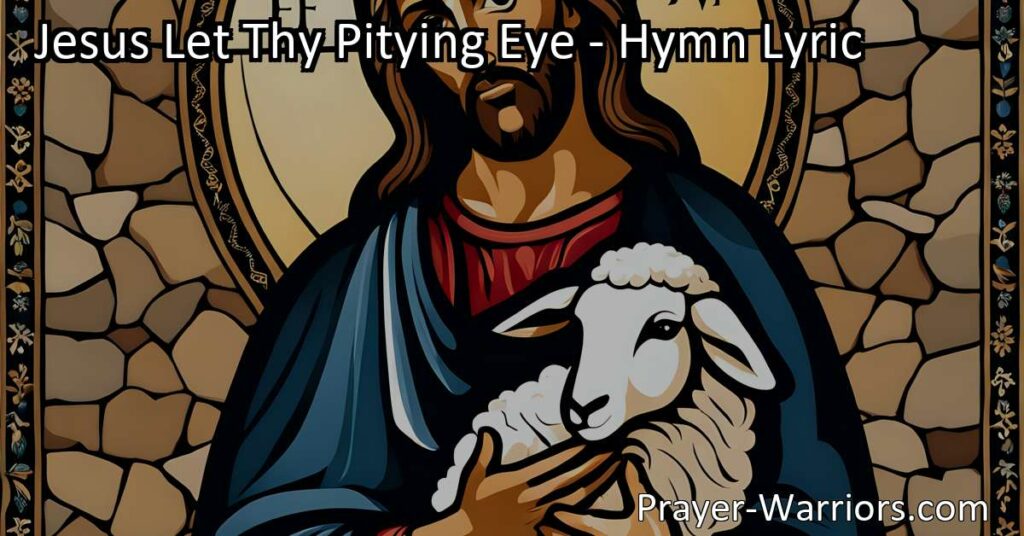Jesus Let Thy Pitying Eye – Hymn Lyric
“Jesus Let Thy Pitying Eye” is a hymn that explores the themes of repentance and redemption. It reminds us that even in our moments of doubt and faithlessness, Jesus offers his boundless love and forgiveness. Through heartfelt pleas and powerful imagery, the hymn invites us to turn back to Jesus, seek his forgiveness, and experience the transformative power of a contrite heart.
Table of Contents
Jesus Let Thy Pitying Eye – Hymn Lyric
Jesus, let Thy pitying eye call back a wandering sheep;
False to Thee, like Peter, I would fain, like Peter, weep;
Let me be by grace restored, On me be all long-suffering shown;
Turn, and look upon me, Lord, And break my heart of stone.
Saviour, Prince, enthrone above, Repentance to impart,
Give me, through Thy dying love, The humble, contrite heart;
Speak the reconciling word, And let Thy mercy melt me down;
Turn, and look upon me, Lord, And break my heart of stone.
For Thine own compassion’s sake The gracious wonder show;
Cast my sins behind Thy back, And wash me white as snow,
Speak my paradise restored Redeem me by Thy grace alone;
Turn, and look upon me, Lord, And break my heart of stone.
Look, as when Thy languid eye Was closed, that we might live;
“Father,” at the point to die My Saviour gasped “forgive!”
Surely, with that dying word, He turns, and looks, and cries, “‘Tis done!”
O my bleeding, loving Lord, Thou break’st my heart of stone!
Meaning of Jesus Let Thy Pitying Eye
Jesus Let Thy Pitying Eye: A Hymn of Repentance and Redemption
In the depths of our hearts, we all have moments when we feel lost and disconnected from our faith. Just like Peter, who denied Jesus three times, we too may find ourselves faltering, unsure of our commitment to the teachings of Christ. And yet, even in these moments of weakness, Jesus extends his boundless love and understanding towards us, inviting us to turn back to Him with repentance and contrition. This beautiful hymn, “Jesus Let Thy Pitying Eye,” encapsulates this longing for forgiveness and restoration.
The hymn opens with a humble plea to Jesus, “Jesus, let Thy pitying eye, call back a wandering sheep.” The speaker acknowledges their own faithlessness and expresses a longing to weep like Peter did, repenting for their actions. This opening verse sets the tone for the rest of the hymn, emphasizing the need for grace and long-suffering from Jesus.
As the verses progress, the speaker continues to express their desire for a heart transformation. They pray, “Let me be by grace restored, on me be all long-suffering shown; turn, and look upon me, Lord, and break my heart of stone.” Here, the imagery of a heart of stone represents spiritual hardness and detachment from God. The speaker longs for Jesus to soften their heart, to break down the walls of pride and falsehood that separate them from a genuine relationship with Him.
The hymn moves on to address Jesus as the Saviour, Prince, and throned above, highlighting His authority and power to grant repentance. The speaker implores Jesus to “give me, through Thy dying love, the humble, contrite heart.” In this verse, the focus shifts to not only asking for forgiveness but also for a complete transformation of the inner self. It is not just about remorse for past actions but a sincere desire to have a contrite heart, ready to receive and follow the teachings of Jesus.
The third verse of the hymn continues the theme of reconciliation and redemption. The speaker begs Jesus to speak the reconciling word and to let His mercy melt them down. This verse underscores the power of God’s mercy, which can redeem even the most broken and sinful among us. The speaker longs for their paradise to be restored and to be redeemed solely by God’s grace.
“For Thine own compassion’s sake, the gracious wonder show; cast my sins behind Thy back, and wash me white as snow,” pleads the speaker in the fourth verse. This verse beautifully captures the essence of forgiveness and renewal. The speaker acknowledges their sins and asks Jesus to cast them behind His back, to remove them from their record. The imagery of being washed white as snow represents the cleansing of one’s sins, leaving the individual blameless and pure in the eyes of God.
The final verse of the hymn recalls Jesus’ final moments on the cross. The speaker reflects on the moment when Jesus, on the brink of death, gasped “forgive.” This powerful image of Jesus’ dying word reminds us of the immense love and forgiveness He offers to all who repent. The speaker is certain that as Jesus uttered those words, He turned, looked, and proclaimed, “‘Tis done!” This declaration brings a profound sense of relief and gratitude to the speaker, as they realize that Jesus’ sacrifice has broken their heart of stone.
In conclusion, “Jesus Let Thy Pitying Eye” is a hymn of repentance and redemption that speaks to the universal longing for forgiveness and renewal. It invites all who feel lost and disconnected from their faith to turn back to Jesus, to seek His forgiveness and to have their hearts softened through His grace. Through its powerful imagery and heartfelt pleas, the hymn serves as a reminder of the boundless love and mercy that Jesus extends to all who sincerely seek Him. May the words of this hymn touch the hearts of many, inspiring them to embrace repentance and the transformative power of a contrite heart.
I hope this hymn inspired image brings you hope and peace. Share it with someone who needs it today!



